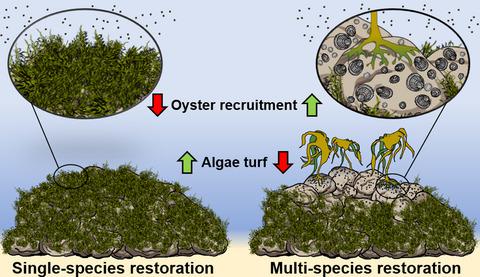当前位置:
X-MOL 学术
›
J. Appl. Ecol.
›
论文详情
Our official English website, www.x-mol.net, welcomes your
feedback! (Note: you will need to create a separate account there.)
Multi‐species restoration accelerates recovery of extinguished oyster reefs
Journal of Applied Ecology ( IF 5.0 ) Pub Date : 2020-07-20 , DOI: 10.1111/1365-2664.13719 Dominic McAfee 1, 2 , Catherine Larkin 1 , Sean D. Connell 1, 2
中文翻译:

多物种恢复加快了灭绝的牡蛎礁的恢复
更新日期:2020-07-20
Journal of Applied Ecology ( IF 5.0 ) Pub Date : 2020-07-20 , DOI: 10.1111/1365-2664.13719 Dominic McAfee 1, 2 , Catherine Larkin 1 , Sean D. Connell 1, 2
Affiliation

|
- A multi‐species approach to habitat restoration may boost the key processes (e.g. recruitment) that enable foundation species to overcome barriers to recovery. Natural systems tend to be formed by co‐occurring foundation species whose synergy drives ecological productivity and resilience beyond that of single foundation species. Yet, restoration remains primarily a single‐species focus enterprise where positive interactions are seldom incorporated into planning. A multi‐species approach that prioritizes species combinations that create emergent properties for their persistence may accelerate habitat recovery and the success of restoration programmes.
- On the largest oyster reef restoration project in the Southern Hemisphere, we experimentally established canopy‐forming kelp to test whether they could accelerate the natural recruitment of oysters to substrata monopolized by turf‐forming algae. To understand whether facilitation of oysters was a function of the kelp themselves (biological facilitation) or the physical environment they create (physical facilitation), we compared recruitment to the understorey of living kelp and synthetic kelp mimics.
- Despite observing high density oyster recruitment to the turf‐free underside of reef boulders (8,300 oysters/m2), turf algae appeared to inhibit oyster recruitment to the exposed surfaces of the reef, limiting their capacity to grow and form complex, three‐dimensional habitat.
- Transplanted kelp, whether living or synthetic kelp mimics, effectively reduced the biomass of turf and enhanced oyster recruitment, creating turf‐free substrata on the upper reef surfaces with up to 26 times the oyster recruitment than turf‐covered substrata.
- Synthesis and applications. Our results provide proof‐of‐concept that incorporating the transplant of canopy‐forming kelp to reefs constructed to restore oysters is not only achievable, but may be imperative to successfully restore oyster reefs in turf‐dominated systems. Kelp transplants suppressed the turf algae that otherwise excluded oysters from the reef surface, effectively shifting the competitive advantage toward oyster recovery by maintaining bare substrata for oyster recruitment. By demonstrating that a multi‐species approach to restoration accelerates the recovery of a restored habitat, we emphasize the value of incorporating the multi‐species concept into restoration planning.
中文翻译:

多物种恢复加快了灭绝的牡蛎礁的恢复
- 采用多物种的栖息地恢复方法可以促进关键过程(例如募集),使基础物种能够克服恢复障碍。自然系统往往由共同存在的基础物种形成,它们的协同作用使生态生产力和复原力超越了单一基础物种。然而,恢复仍然主要是单一物种为重点的企业,很少将积极的互动纳入计划中。优先考虑能够为持久性创造出新特性的物种组合的多物种方法可能会加速栖息地的恢复和恢复计划的成功。
- 在南半球最大的牡蛎礁修复项目中,我们通过实验建立了形成冠层的海带,以测试它们是否可以加速将牡蛎自然招募到由形成草皮的藻类垄断的基质中。为了了解牡蛎的促进作用是海带本身的功能(生物促进作用)还是它们创造的物理环境(身体的促进作用),我们将生海带和合成海带模拟物的底层吸收进行了比较。
- 尽管观察到高密度的牡蛎聚集到礁石的无草皮下侧(8,300牡蛎/ m 2),但是草皮藻似乎抑制了牡蛎向礁石裸露表面的聚集,从而限制了它们的生长和形成复杂的三维空间的能力。栖息地。
- 移植的海带,无论是活的还是合成的海带模拟物,都有效地减少了草皮的生物量并增强了牡蛎的吸收,在上礁石表面上产生了无草皮的基质,其牡蛎的吸收高达草皮覆盖的基质的26倍。
- 综合与应用。我们的结果提供了概念证明,证明将冠层形成的海带移植到为恢复牡蛎而建造的珊瑚礁中不仅是可以实现的,而且对于在以草皮为主的系统中成功恢复牡蛎礁也可能是必不可少的。海带移植抑制了原本可以将牡蛎从礁石表面排除的草皮藻类,通过保持裸露的牡蛎基层有效地将竞争优势转移到了牡蛎恢复上。通过证明多物种恢复方法可以加快恢复栖息地的恢复速度,我们强调了将多物种概念纳入恢复计划的价值。











































 京公网安备 11010802027423号
京公网安备 11010802027423号